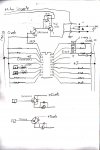OK.
As I have mentioned before I am trying to replace an old 18 pin pic with the new 18M2 on an exisitng OLD board.
I also mentioned that I suck at electronics........(no kidding huh!)
To keep hippy, dippy, kippy, and anyonle else ending in ippy happy, I have tried to draw the circuit from the old board. (see below)
I do have a few questions about the TIP122. Does the TIP122 and the R/C circuit look correct? Keep in mind that there are two separate power supplies. One for the motor and one for the controls.
Second question, are the legs on all TIP122 the same? I have a couple old boards where the collector and emmiter legs are swaped, same PCB layout though.
Thanks ahead of time.
As I have mentioned before I am trying to replace an old 18 pin pic with the new 18M2 on an exisitng OLD board.
I also mentioned that I suck at electronics........(no kidding huh!)
To keep hippy, dippy, kippy, and anyonle else ending in ippy happy, I have tried to draw the circuit from the old board. (see below)
I do have a few questions about the TIP122. Does the TIP122 and the R/C circuit look correct? Keep in mind that there are two separate power supplies. One for the motor and one for the controls.
Second question, are the legs on all TIP122 the same? I have a couple old boards where the collector and emmiter legs are swaped, same PCB layout though.
Thanks ahead of time.
Attachments
-
488.8 KB Views: 74
Last edited:

